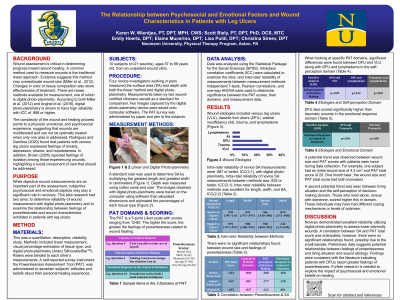Clinical Research
(CR-061) The relationship between psychosocial and emotional factors and wound characteristics in patients with leg ulcers
Friday, April 28, 2023
7:15 PM - 8:30 PM East Coast USA Time

Scott Biely, PT, PhD, DPT, OCS; Emily Hoertz, PT, DPT; Lisa Puliti, PT, DPT
Introduction: Wound assessment is critical in determining progress toward wound healing. While objective wound measurements are an essential part of the assessment, psychosocial and emotional aspects may play a significant role in recovery. This pilot research had two aims: to determine the reliability of wound measurement with digital photo-planimetry and examine the relationship between feelings of powerlessness and wound characteristics in patients with leg ulcers.
Methods: This was a quantitative, descriptive, reliability study. Wounds were measured by different novice investigators and compared to the data obtained by experts. Methods included linear measurement and visual percentage estimation of tissue type using digital photo-planimetry. A self-reported survey instrument, the Powerlessness Assessment Tool (PAT), was administered to ascertain attitudes and beliefs about healing. Data were analyzed using the Statistical Package for the Social Sciences (SPSS). Intraclass correlation coefficients (ICC) were calculated to examine the intra- and inter-rater reliability of measurements between measurement methods. Independent T-tests, Pearson correlations, and one-way ANOVA were used to determine the significance between the PAT scores, domains, and measurement data.
Results: 10 subjects (n=21 wounds), ages 57 to 99 years old, with etiologies including venous ulcers, diabetic foot ulcers, arterial insufficiency, trauma, and lymphedema. Surface area (SA) measurements using digital photo-planimetry showed excellent intra-rater reliability (ICC 3,1) = .989 and inter-rater reliability (ICC 2,2) = .996, and .950 or better for tissue type identification. Inter-rater reliability between novice investigator digital photo-planimetry and expert linear assessment was excellent (ICC 2,2) = .948. A significant relationship (p=.018) was found between subjects living alone and PAT emotional domain scores. There were significant differences between subjects with diabetic foot ulcers and other etiologies when looking at mean self-perception domain (p=.036) and emotional domain (p=.050) scores. No significant correlations were found between SA or chronicity and feelings of powerlessness.
Discussion: Novices demonstrated excellent reliability when utilizing digital photo-planimetry to assess lower extremity wounds. Preliminary data trended toward significant relationships between feelings of powerlessness and living situation and wound etiology. Patients' attitudes and beliefs about their healing process may impact the healing rate. Future research should explore these relationships to better provide patient-centered wound management.
Methods: This was a quantitative, descriptive, reliability study. Wounds were measured by different novice investigators and compared to the data obtained by experts. Methods included linear measurement and visual percentage estimation of tissue type using digital photo-planimetry. A self-reported survey instrument, the Powerlessness Assessment Tool (PAT), was administered to ascertain attitudes and beliefs about healing. Data were analyzed using the Statistical Package for the Social Sciences (SPSS). Intraclass correlation coefficients (ICC) were calculated to examine the intra- and inter-rater reliability of measurements between measurement methods. Independent T-tests, Pearson correlations, and one-way ANOVA were used to determine the significance between the PAT scores, domains, and measurement data.
Results: 10 subjects (n=21 wounds), ages 57 to 99 years old, with etiologies including venous ulcers, diabetic foot ulcers, arterial insufficiency, trauma, and lymphedema. Surface area (SA) measurements using digital photo-planimetry showed excellent intra-rater reliability (ICC 3,1) = .989 and inter-rater reliability (ICC 2,2) = .996, and .950 or better for tissue type identification. Inter-rater reliability between novice investigator digital photo-planimetry and expert linear assessment was excellent (ICC 2,2) = .948. A significant relationship (p=.018) was found between subjects living alone and PAT emotional domain scores. There were significant differences between subjects with diabetic foot ulcers and other etiologies when looking at mean self-perception domain (p=.036) and emotional domain (p=.050) scores. No significant correlations were found between SA or chronicity and feelings of powerlessness.
Discussion: Novices demonstrated excellent reliability when utilizing digital photo-planimetry to assess lower extremity wounds. Preliminary data trended toward significant relationships between feelings of powerlessness and living situation and wound etiology. Patients' attitudes and beliefs about their healing process may impact the healing rate. Future research should explore these relationships to better provide patient-centered wound management.

.png)